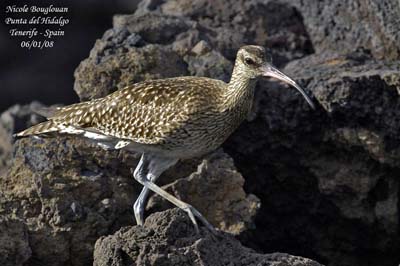
Whimbrel – Numenius phaeopus
Charadriiforme Order - Scolopacidae Family
BIOMETRICS:
Length: 40 à 45 cm; Wingspan: 75 à 90 cm
Weight: male: 350 g; female: 400 g
DESCRIPTION:

Smaller than the Eurasian Curlew (Numenius arquata), the small head shows blackish-brown crown with median longitudinal pale stripe from forehead to nape, and whitish eyebrows. The upperparts are dark brown, with pale streaks and spots. The rump is white, tapering into a point in the middle of the back. The uppertail coverts are white, barred with brown. The tail is grey, with almost white edges, and barred with dark brown.
The bill is dark brown with pink base in lower mandible. The eyes are dark brown. Legs and feet are bluish-grey.
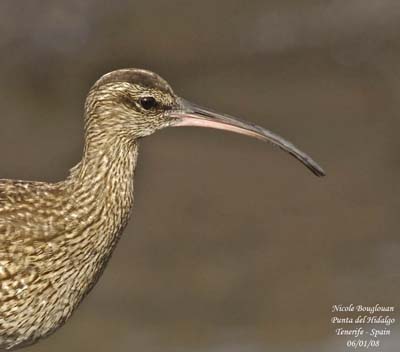
VOICE: SOUNDS BY XENO-CANTO
The Whimbrel’s usual call is a rapid “neigh” or stammering, a series of 6 to 8 soft whistles “dididididididi” or “puhuhuhuhuhuhuhu” uttered with variable intensity, sometimes accompanied by a simple “curliii” if the bird is suddenly excited. Its calls are more varied in the breeding areas, including a kind of joyful song given during the flight displays, and then, a whinnying trill.
HABITAT:
The Whimbrel lives mainly on coasts, but also in tundra and peat bogs. It frequents the marshes of boreal, subarctic and subalpine areas, the forests of birches and the tundra close to the treeline, open mountain forests and river valleys.
In migration, it may be found in wetlands, tidal areas, and dry or wet meadows. In spring, it prefers the heath lands where it can find berries, and the farmlands. In winter, it is found mainly in coasts, occurring on exposed reefs, muddy, rocky and sandy beaches, tidal areas and mudflats in mangroves.
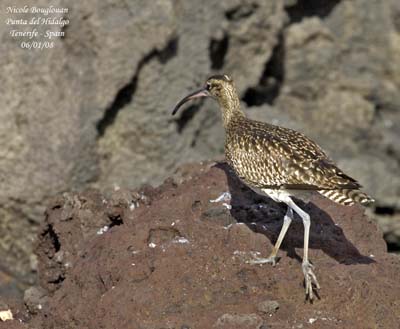
RANGE:
The Whimbrel breeds in northern Europe (Scandinavia, Finland, Russia, Iceland, Faroe Islands, Scotland), in Siberia and North America. It winters in South Africa (in north-west, south and east of Africa), in the south of Asia, and sometimes in the Spanish coasts. The birds living in North America migrate towards South America, to the Tierra del Fuego.
BEHAVIOUR:
The Whimbrel is a bird which we find more on coastal areas than its close cousin, the Eurasian Curlew (Numenius arquata). It remains in groups on the coastal rocks and beaches during the migrations. It rests and sleeps in flocks in the salt marshes, around the salty pools, often with Semipalmated Sandpipers. It is migratory. It leaves the breeding areas by travelling along the European coasts. Less frequently, it flies over the central part of our continent. It joins at this moment other individuals in Central Europe, on vast muddy areas of the empty ponds, meadows and fields near water. It migrates in spring and autumn with few stopovers. The Whimbrel is monogamous and solitary, it often seen alone, but it is fairly gregarious outside the breeding season.

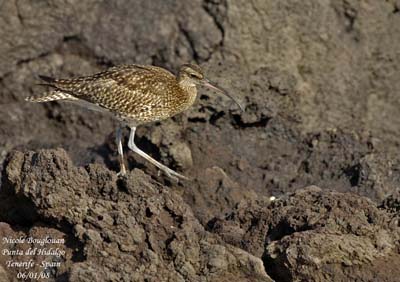
It feeds by pecking on the ground or the water surface, less often by immersing the head. It probes into the mud to find small invertebrates, and pecks to capture small crabs or other preys similar at the surface. It probes deeply and moves while feeding. It may also capture fairly large preys which it will tear to pieces for swallowing them. It rinses its food if it is muddy. At high tide, they search for food along the coasts in large flocks.
FLIGHT:
The Whimbrel migrates in noisy groups, forming an irregular flock or a chevron-shaped line. Its wing beats are a little faster than those of the Eurasian Curlew. When in flight, one can see its white rump, whose colour is tapering into a point to the middle of the back.
REPRODUCTION:
The Whimbrel nests in loose colonies. It returns on the breeding areas at mid- April to May. The nest is on the ground, in open place, in a shallow depression. The female lines it with vegetation such as dry grasses, moss and lichens, but it is not regular.
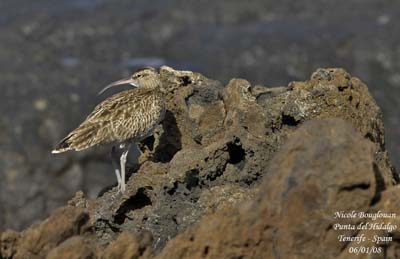
She usually lays 4 pale green to olive-green eggs, mottled with brown. Incubation lasts about 24 to 28 days, shared by both parents, but mainly by the female. After the hatching and as soon as they are dry, the chicks leave the nest and hide in the surrounding. They are covered with buff down mottled blackish-brown above. They have brown crown with paler median line, and buff belly. Both adults raise the chicks and are aggressive towards the intruders, being animals or human, which enter their territory. The female leaves the area first, and the male remains until the first flights of the young, at about 4 to 6 weeks of age. They reach their sexual maturity at two years.
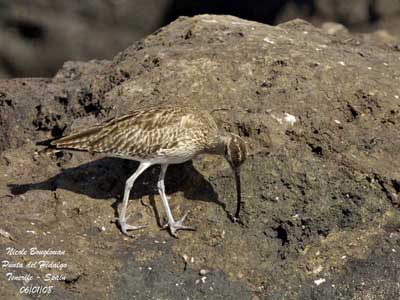
DIET:
Inland, the Whimbrel feeds on insects and larvae, earth worms, molluscs, spiders and other small invertebrates. It consumes also some plants, small berries and seeds. On the coast, it also takes crabs and other shellfish, molluscs, sometimes fish, reptiles and birds.
PROTECTION / THREATS / STATUS:
Populations are not threatened any more and numbers are become stable again, after the decline observed at the end of the 19th century, due to hunting during the migrations.
Fr: Courlis corlieu
All : Regenbrachvogel
Esp : Zarapito trinador
Ital : Chiurlo piccolo
Nd : Regenwulp
Russe : Средний кроншнеп
Sd : Småspov
Text and photographs by Nicole Bouglouan
Sources:
THE HANDBOOK OF BIRD IDENTIFICATION FOR EUROPE AND THE WESTERN PALEARCTIC by Mark Beaman, Steve Madge - C.Helm - ISBN: 0713639601
All About Birds - Cornell Lab of Ornithology
Birds in backyards (Birds Australia and Australian Museum)
Wikipedia (Wikipedia, The Free Encyclopedia)
What Bird-The ultimate Bird Guide (Mitchell Waite)